Warts
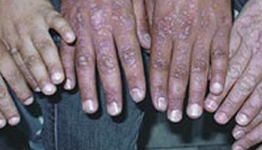
Flat warts - are often too numerous to treat with methods mentioned above. As a result ‘peeling’ methods using daily applications of salicylic acid or other surface peeling preparations are often recommended. For some adults, periodic office treatments are sometimes necessary.
Genital warts - are perhaps the most difficult to treat. First, all warts must be located. This may require an examination of the vagina and cervix in women and the rectum in both sexes. Periodic office treatments with acids or freezing may be needed to get rid of the visible warts. The dermatologist may prescribe a form of podophyllin which can be used at home.
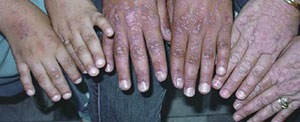
With very stubborn or very large genital warts, one of the surgical treatments is an option. The patient’s sexual partner should also be examined for warts by a dermatologist.
Genital warts can be very difficult to cure. Occasionally even multiple treatments will not guarantee success.
What are some of the other treatments for warts?
There are at least two different lasers used for the treatment of warts. Laser therapy is used to destroy some types of warts. But lasers are more expensive and may require the injection of a local anaesthesia to numb the area treated.
Another treatment is to inject each wart with an anti-cancer drug called Bleomycin. The injections may be painful and can have other side effects.
Another method of treatment is Immunotherapy, which attempts to build up the body’s own rejection system. Several methods of immunotherapy are being used. With one method the patient is made allergic to a certain chemical which is then painted on the wart. A mild allergic reaction occurs around the treated warts, and may result in the disappearance of the warts. Warts may also be injected with interferon, a treatment to boost the immune reaction and cause rejection of the wart.
Can I treat my own warts without seeing a doctor?
There are some wart remedies available without a prescription. However, you might mistake another kind of skin growth for a wart, and end up treating something more serious as though it were a wart. If you have any questions about either the diagnosis or the right way to treat a wart, you should seek your dermatologist’s advice.
What about the use of hypnosis or ‘folk’ remedies?
Many people, patients and doctors alike, believe folk remedies and hypnosis are effective. Since warts, especially in children, may disappear without treatment, it’s hard to know whether it was a folk remedy or just the passage of time that led to the cure. Since warts are generally harmless, there may be times where these treatments are appropriate. Medical treatments can always be used if necessary.
What about the problem of recurrent warts?
Sometimes it seems as if new warts appear as fast as old ones go away. This may happen because the old warts had shed virus into the surrounding skin before they were treated. In reality new “baby” warts are growing up around the original “mother” warts. The best way to limit this is to treat new warts as quickly as they develop so they have little time to shed virus into nearby skin. A check by your dermatologist can help assure the treated wart has resolved completely.
Is there any research going on about warts?
Research is moving along very rapidly. There is great interest in new treatments, development of a vaccine against warts, and development of natural immunity to warts. We hope there will be a solution to the annoying problem of warts in the not too distant future.
What are warts?
Warts are non-cancerous skin growths caused by a viral infection in the top layer of the skin or mucous membranes. Viruses that cause warts belong to a family called human papilloma virus (HPV). The appearance of a wart depends on where it is growing. Warts are usually skin-colored and feel rough to the touch, but they can be dark, flat and smooth.
How many kinds of warts are there?
There are several different kinds of warts including:
- Common warts
- Foot warts
- Flat warts
- Genital warts
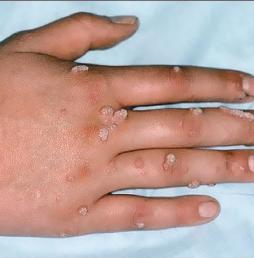
Common warts - usually grow around the nails, on the fingers and on the backs of the hands. They are more common where skin has been broken, for example where fingernails are bitten or hangnails picked.
Foot warts - are usually on the soles of the feet and are called plantar warts. When plantar warts grow in clusters they are known as mosaic warts. Most plantar warts do not stick up above the surface like common warts because the pressure of walking flattens them and pushes them back into the skin. These warts often have black dots that are the blood vessels feeding them. Plantar warts have a bad reputation because they can be painful, feeling like a stone in the shoe.
Flat warts are smaller and smoother than other warts. They tend to grow in great numbers 20 to 100 at anyone time. They can occur anywhere, but in children they are most common on the face. In adults they are often found in the beard area in men and on the legs in women. Irritation from shaving probably accounts for this.
Genital warts (also called Condyloma), have become a common and worrisome problem in adults. They tend to be small and flat but can be thin and tall. These are soft and are not rough or scaly like other warts. They can occur on the genitalia, within the vagina, on the cervix in women, and around the anus or within the rectum. The HPVs that cause genital warts rarely cause warts of the hands or feet but can cause warts in the mouth. Genital warts have been linked to cancer of the genital area.
How do you get warts?
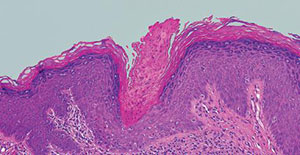
Warts probably are passed from person to person, sometimes indirectly. The time from the first contact to the time the warts have grown large enough to be seen is often several months. The risk of catching hand, foot and flat warts is small. Genital warts seem to be more contagious. It is important to use precautions to limit the spread of genital warts to one’s sexual partner.
Why do some people get warts and others don’t?
Some people get warts depending on how often they are exposed to the virus. Wart viruses occur more easily if the skin has been damaged in some way, which explains the high frequency of warts in children who bite their nails or pick at hangnails. Some people are just more likely to catch the wart virus than are others, just as some people catch colds very easily. Patients with a weakened immune system also are more prone to a wart virus infection.
Do warts need to be treated?
In children, warts often disappear without treatment over a period of several months to years. However, since warts can be spread to others and can be spread to new areas or other people, it is reasonable to treat most children, especially if the warts are bothersome or painful.
Warts in adults often do not disappear as easily or as quickly as they do in children. There is some increased possibility of skin cancer at the site of long-standing genital warts. Women with genital warts also have an increased risk of cancer of the cervix. For these reasons all adults with genital warts should be treated. Women should have regular PAP tests, even after treatment.
How do dermatologists treat warts?
Planter’s Warts
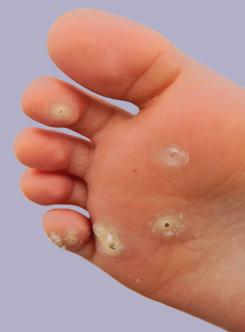
Common warts in young children can be treated at home by their parents on a daily basis by painting on low strength salicylic acid. There is usually little discomfort but it can take many weeks of treatment to obtain favourable results. Treatment should be stopped at least temporarily if the wart becomes sore. Weekly “painting” with cantharidin in the dermatologist’s office causes a blister to form under the wart. The dermatologist can then clip away the dead part of the wart in the blister roof in a week or so.
For adults and older children cryotherapy (freezing) is generally preferred. This treatment is not too painful and rarely results in scarring. However, repeat treatments at one to three week intervals are often necessary. Electrosurgery (burning) is another good alternative treatment, removing the wart during a single office visit. However, scarring and pain are more likely to occur than with freezing.
Plantar warts - are difficult to treat because the bulk of the wart lies below the skin surface. Treatments include the use of salicylic acid plasters, applying other chemicals to the wart, or one of the surgical treatments including laser surgery, electrosurgery, or cutting. The dermatologist may recommend a change in footwear to reduce pressure on the wart or methods to reduce foot sweating.



